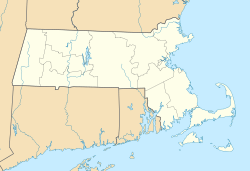Fay Club facts for kids
Quick facts for kids |
|
|
Fay Club
|
|
 |
|
| Location | 658 Main St., Fitchburg, Massachusetts |
|---|---|
| Built | 1884 |
| Architect | Richard M. Upjohn |
| Architectural style | Gothic |
| NRHP reference No. | 78000470 |
| Added to NRHP | 31 January 1978 |
The Fay Club is a special private club found at 658 Main Street in Fitchburg, Massachusetts. It has been around since 1910. The building where the club meets was first designed in 1883. It was built in 1884 as a home for George Fay and his daughter Lucy. In 1978, this historic building was added to the National Register of Historic Places. This means it's a very important place in history.
The Fay Club Building
The old Fay Club building is in downtown Fitchburg. You can find it on the south side of Main Street. It stands between Wood Place and Newton Place, right next to the public library.
It is a big and unique building made of red brick. It has special sandstone decorations. The building is two and a half stories tall. It has an interesting, uneven shape and decorations. These styles were popular during the late Victorian Gothic period. The roof is shaped like a pyramid with a pointed top. There are also parts of the roof that stick out with gables. You can see these on the north and east sides. The building also has two tall chimneys with fancy brickwork. Inside, the first floor still looks much like it did originally. It has beautiful carved wood and painted pictures on the walls.
History of the Club
George Flagg Fay was a well-known businessman in Fitchburg. He was one of the first members of the Park Club, which started in 1881. This club was located close to his new home. George Fay built the house at 658 Main Street between 1883 and 1884. Its location made it easy for him to walk to the Park Club.
When George Fay passed away, his daughter Lucy inherited the house. She lived there until 1910. Then, she moved to another part of the country. Lucy decided to give her father's house to the Park Club. The club was very thankful for this gift. To show their appreciation, the members voted to change the club's name. They renamed it the Fay Club in honor of George Fay.
At that time, the club was in the middle of a busy business area. It was a place where people could meet, eat, and connect with others. Over time, families of members also used the club. It became a popular spot for weddings, parties, and family get-togethers.
However, as the city grew, its main activities moved to the suburbs. Because of this, the number of club members slowly went down. For the last 30 years it was open, the club would close during the summer. It would then reopen in September. In June 2015, the club's leaders decided that the summer closing would be permanent.
In January 2016, the building was put up for sale. But by October 2016, something amazing happened! A small group of active members worked hard to raise money and support. Because of their efforts, the Fay Club was able to reopen its doors.
See also


